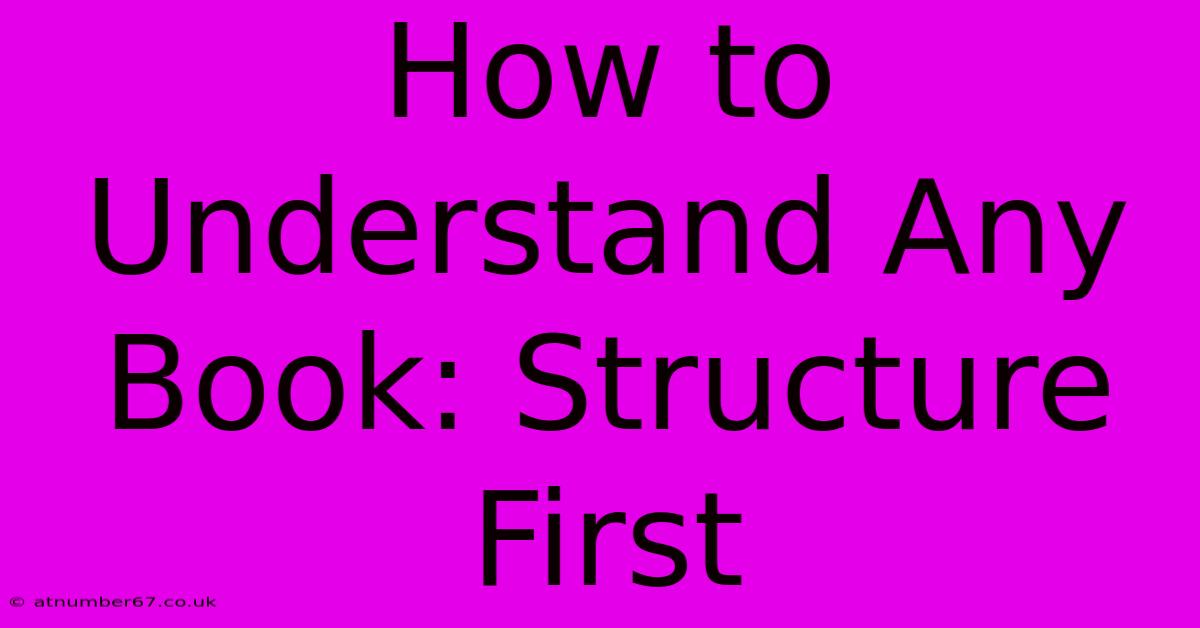How To Understand Any Book: Structure First

Table of Contents
- How to Understand Any Book: Structure First
- Why Structure Matters
- Identifying the Book's Core Structure
- Active Reading Techniques for Structural Understanding
- 1. Skimming and Scanning:
- 2. Note-Taking and Outlining:
- 3. Summarizing Each Chapter:
- 4. Identifying Key Concepts and Arguments:
- Beyond Structure: Engaging with the Content
- Conclusion: Mastering the Art of Book Comprehension
How to Understand Any Book: Structure First
Understanding a book isn't just about reading the words; it's about grasping the author's intent and the overall message. Many struggle with complex texts, feeling overwhelmed and lost. But there's a powerful technique that can unlock even the most challenging books: focusing on structure first. This approach prioritizes understanding the book's architecture before diving into the details, providing a solid framework for comprehension.
Why Structure Matters
Before you get bogged down in individual chapters or dense paragraphs, consider the big picture. A book's structure isn't arbitrary; it reflects the author's logical progression of ideas. Understanding this structure acts as a roadmap, guiding you through the author's argument and making the individual parts much more digestible. Think of it like building a house: you wouldn't start decorating before laying the foundation. Similarly, grasping a book's structure provides the essential foundation for true understanding.
Identifying the Book's Core Structure
Different books employ different structures. Some common structures include:
- Chronological: Events unfold in a linear, time-based sequence. Histories and biographies often follow this structure.
- Thematic: The book explores a central theme through various examples and perspectives. This structure is common in philosophical or sociological works.
- Comparative: The book contrasts and compares different ideas, theories, or approaches.
- Problem-Solution: The book identifies a problem and proposes solutions. This is common in self-help or how-to books.
- Narrative: The book tells a story, focusing on character development and plot progression.
Identifying the primary structure is your first step. Skimming the table of contents, reading the introduction and conclusion, and paying attention to chapter headings will help you pinpoint the organizational method.
Active Reading Techniques for Structural Understanding
Once you've identified the structure, it's time to engage in active reading techniques that reinforce your understanding of the framework:
1. Skimming and Scanning:
Don't just read every word from cover to cover. Skim the introductory and concluding sections to grasp the author's overall argument and main points. Scan chapter headings and subheadings to get a sense of the flow and progression of ideas.
2. Note-Taking and Outlining:
As you read, take notes outlining the main points of each chapter or section. Create a visual representation of the book's structure – a mind map or simple outline can be incredibly helpful. This active process reinforces your understanding and helps to identify connections between different parts of the book.
3. Summarizing Each Chapter:
After reading each chapter, take a few minutes to summarize its main arguments in your own words. This forces you to engage with the material actively and check for comprehension.
4. Identifying Key Concepts and Arguments:
Pay close attention to recurring themes, key concepts, and the author's main arguments. Highlight these in your notes or text, making them easily retrievable for later review.
Beyond Structure: Engaging with the Content
While understanding the structure is paramount, it's not the only aspect of comprehension. Once you have a solid grasp of the overall architecture, you can delve deeper into the specifics:
- Analyze the author's tone and style: Understanding the author's perspective and writing style adds another layer of meaning.
- Identify supporting evidence: Look for the evidence the author uses to support their claims. Evaluate the strength and validity of this evidence.
- Consider counterarguments: A strong book will acknowledge and address potential counterarguments. Consider these alternative viewpoints to strengthen your own understanding.
Conclusion: Mastering the Art of Book Comprehension
Understanding any book effectively requires a strategic approach. By prioritizing the structure first, you create a strong foundation for deeper comprehension. Using active reading techniques and focusing on the author's overall argument, you can unlock even the most challenging texts, turning potential frustration into a rewarding intellectual experience. Mastering the art of reading means understanding not just the words, but the architecture of the author's thoughts.

Thank you for visiting our website wich cover about How To Understand Any Book: Structure First. We hope the information provided has been useful to you. Feel free to contact us if you have any questions or need further assistance. See you next time and dont miss to bookmark.
Featured Posts
-
Happy Birthday To My Little Miracle One Year Old
Apr 01, 2025
-
Navigating The Terminology Estado Gobierno And Nacion
Apr 01, 2025
-
Rohit Age A Reflection Of Time
Apr 01, 2025
-
Faisal Qureshis Son Living Under The Pressure
Apr 01, 2025
-
Zahide Tiktok Age Its Official
Apr 01, 2025
